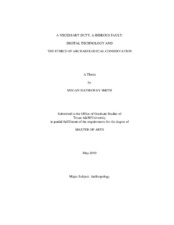| dc.description.abstract | Archaeological conservation is the process by which conservators prevent deterioration of archaeological remains and provide insight into the nature of recovered material. This thesis examines the effect of digital technology upon the ethics of the conservation profession and upon the attitude of the lay-public towards archaeology. The ethical issues raised by the use of digital technology are discussed, particularly the ways in which these issues differ from those raised by traditional conservation methods.
Technological advancements, particularly those occurring in the 20th century, changed the way artifacts are conserved and studied. Conservation arose out of a craft-restoration tradition and evolved into a profession which, in addition to necessary artistic and aesthetic considerations, uses a demonstrable scientific method in order to preserve artifacts. The creation of guidelines for practice and various codes of ethics is the turning point in this evolution, marking the point after which conservation became a scientific profession.
Advances in computer technology have permitted the widespread use of devices such as 3-D scanners, digital CT scanners, and digital cameras in the conservation of archaeological artifacts. All of these pieces of equipment produced digital files which must be stored. Currently, the pace of technological change renders most data inaccessible within ten years, and data conservation problems such as storage, access, and file format have not been adequately addressed by the professional conservation community. There is a distinct lack of formal ethical guidelines concerning these issues; this thesis concludes that there is an extreme need for measured consideration before digital methods are used in archaeological conservation.
The creation of high-fidelity replicas presents a problem for the museum audience. The public connects with artifacts on an emotional level which is altered when a replica is displayed instead of an original. Digital reconstructions abound in popular culture, heavily influencing public opinion, and often resulting in widespread misperception of the information which can be extracted from archaeological evidence. As a result, conservators of the future must be cautious when creating digital artifacts, and must be meticulously careful to make the nature of digital reconstruction clear to the audience, in order to avoid spreading misinformation. | en |


